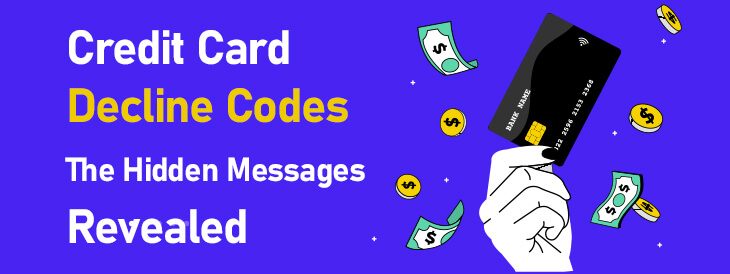Credit Card Decline Codes: The Hidden Messages Revealed
Credit Card Decline Codes: The Hidden Messages Revealed

The payment processing industry has its own coded language – a set of numbers, abbreviations, and terms that communicate everything from the success of a transaction to specific issues preventing a purchase.
Among these is a group of messages called “Credit Card Decline Codes,” messages that remain largely cryptic to cardholders and sometimes even merchants.
This article will uncover the hidden meanings behind these codes and explain how understanding them can help streamline your transactions and improve your payment experience.
Unveiling the Mystery: What are Credit Card Decline Codes?
Let’s shine some light on credit card decline codes. These mysterious sequences of numbers or letters pop up when a credit card transaction hits a roadblock.
They serve as a cryptic conversation between various parties involved in the transaction: banks, credit card networks, merchants, and payment processors. Each code carries a specific message explaining why a transaction couldn’t sail through.
The catch? The codes aren’t universal; they vary from one payment processor to the next. It’s like a secret handshake – unless you’re in the know, it can seem like a perplexing puzzle.
Some Related Blogs
- Low Risk Vs High Risk – What’s Best For Your Business?
- Adult Toys Merchant Account: What Every Business Should Know
- The Ins And Outs Of Setting Up A Merchant Account Reserve
- Maximizing Profits With Cbd: Understanding The Benefits Of A Merchant Account
Reading Between the Lines: The Most Common Decline Codes and Their Meanings
Dive headfirst into the world of decline codes with us! The code “05” might leave you puzzled, but it’s the bank’s cryptic way of saying ‘Do not honor,’ without elaborating why. Code “51” isn’t a call to the police, it simply means ‘Insufficient Funds’ – your account can’t cover the transaction.
Spot a “14”? That’s your cue for ‘Invalid Card Number,’ indicating the entered details don’t match any active card. Lastly, the “54” code doesn’t herald an alien invasion, it’s just the universe’s way of saying ‘Expired Card.’
Looking Within: The Role of the Cardholder in Transaction Declines
Cardholders, let’s shine a spotlight on ourselves.
We’re part of this coded conversation too! Sometimes, we’re the culprits behind those dreaded decline codes. Perhaps we punched in the wrong card number or expiration date, or maybe we had a bit too much retail therapy and maxed out our credit limit.
Even a sudden splurge outside our usual spending habits can set off a fraud alert, halting our transaction in its tracks. So, it’s essential we stay vigilant about our card usage to keep those transactions flowing smoothly.
Recognizing the Players: Merchant and Issuer Responsibility
In the game of transaction approvals, merchants and credit card issuers are key players. A merchant’s task doesn’t end at offering great products; they also need to embrace cutting-edge payment processing software.
Why? Well, antiquated systems can invite unwanted declines. Now, let’s turn the spotlight to credit card issuers.
They hold the reins of cardholders’ transactions and should keep them informed about any brewing storm that might cause a transaction to sink.
It’s like a game of chess: every move counts, every player is important, and keeping each other in check ensures a win-win for all.
So, here’s to effective teamwork, smoother transactions, and fewer decline codes!
Proactive Measures: How to Avoid Card Decline Issues
A stitch in time saves nine, and the same goes for avoiding card decline issues. Cardholders, keep an eagle eye on your spending habits and make sure your card details are always current.
Quick responses to fraud alerts can also make all the difference. Merchants, staying on top of technological advances in payment processing software can save you from many a decline woe. Remember, open communication channels with your payment processors can pave the way to seamless transactions. It’s all about staying one step ahead of the game.
Clear Communication: Importance of Translating Decline Codes to Customers
Keeping customers in the dark is never a good strategy, especially when it comes to transaction declines. It’s crucial for merchants to shed light on those cryptic codes.
You see, ‘Do Not Honor’ might as well be a foreign language to customers, and it’s just a recipe for confusion and lost business. The solution? Translating those codes into clear, understandable language.
This way, customers can comprehend the reasons for transaction failures, leading to less frustration and improved customer relationships. So, merchants, don your translation hats – it’s time to turn ambiguity into clarity.
Navigating the Road Ahead: Future of Credit Card Transactions
Imagine a future where cryptic decline codes are replaced with simple, clear language that everyone can understand. Imagine receiving immediate alerts deciphering the cause of a transaction failure, enabling you to take swift corrective action.
As we continue to evolve within the payment processing industry, we could very well see these changes become a reality. By gaining a deep understanding of credit card decline codes, we’re paving the way towards seamless transactions.
We’re embarking on a journey to make payment roadblocks a thing of yesteryears and propelling us towards a future where every transaction is smooth sailing. Get ready to embrace this change and wave goodbye to the days of declined transactions.
![]()
Email us anytime!
Email customer service 24/7 at info@binarygateways.com
![]()
Call us anytime!
Reach customer care 24/7 at (801) 761-5001
